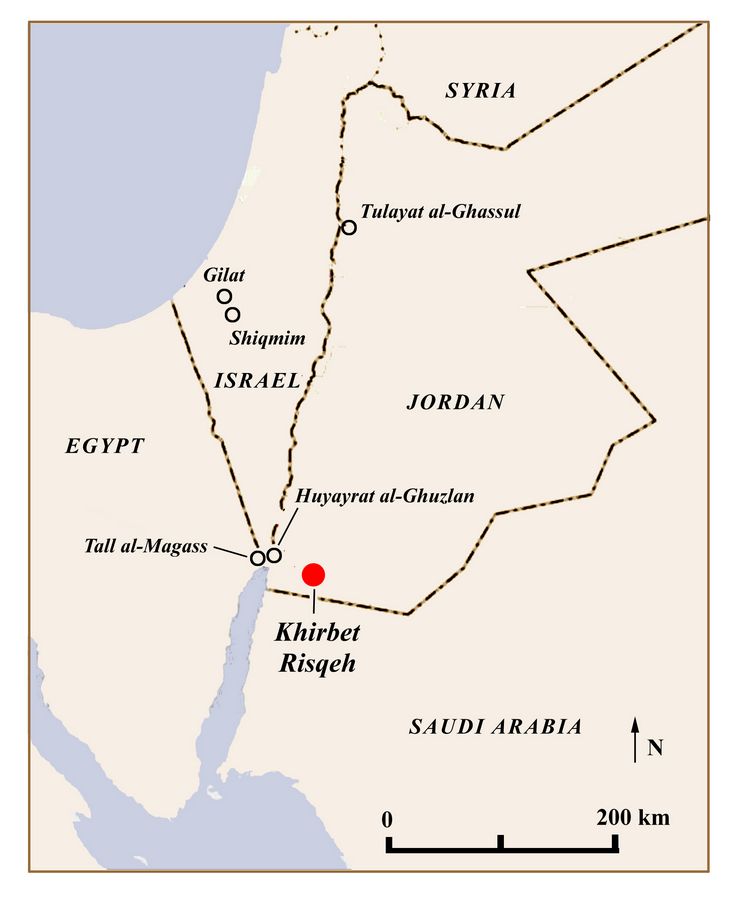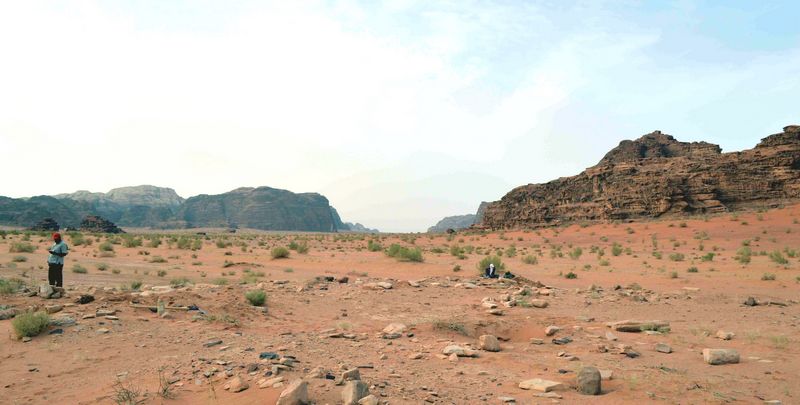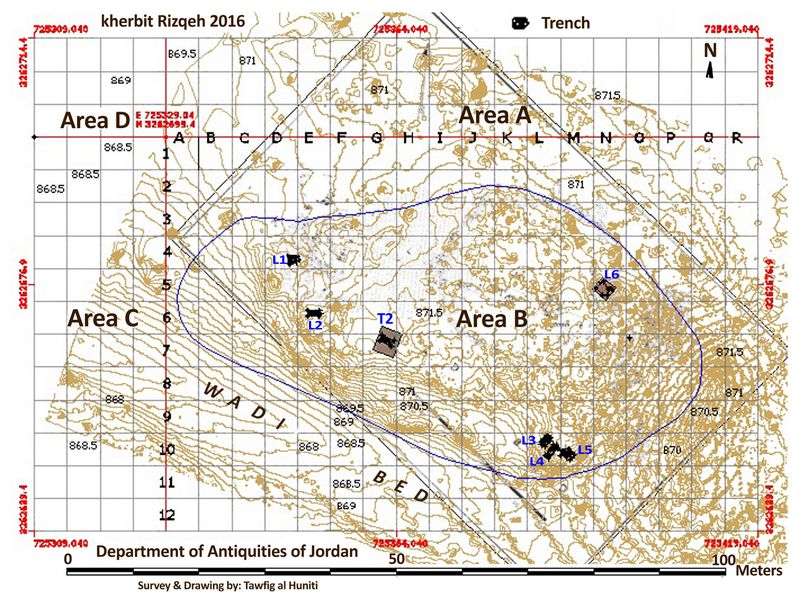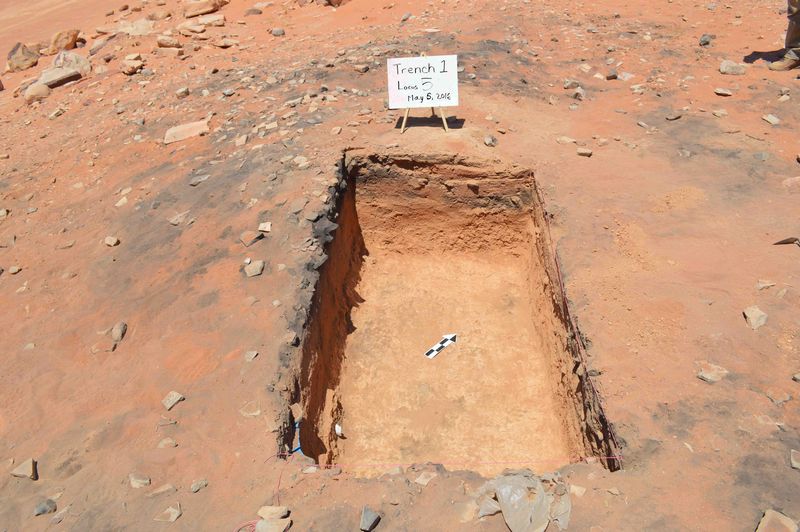Rust Family Foundation: Archaeology Grants Program
Risqeh Archaeological Project
[RFF-2016-04]
Principal Investigator: Max Price, Harvard University
[RFF-2016-04]
Principal Investigator: Max Price, Harvard University
Importance of the Research
The Risqeh Archaeological Project (RAP) seeks to understand how power was negotiated through communal ritual in the Chalcolithic period (5th-4th millennia BC) in the southern Levant. The Chalcolithic period saw economic specialization and new forms of community organization that cr
 eated complex
societies, changing the social landscape of the Near East
forever. Risqeh is a small mound (measuring only about 2500
square meters) in the Wadi Rum Protected Area in Jordan that has been
identified as a non-habitational cultic site dating to the 5th
millennium. As such, Risqeh is an ideal testing ground for
prevailing anthropological theories about how elites gain and maintain
power by manipulating space and knowledge in highly charged ritual
performances. Understanding how Chalcolithic communities
organized and practiced large-scale rituals in locations remote from
habitation sites will allow scholars to better document the
multi-faceted nature of the transition to complex societies in the Near
East.
eated complex
societies, changing the social landscape of the Near East
forever. Risqeh is a small mound (measuring only about 2500
square meters) in the Wadi Rum Protected Area in Jordan that has been
identified as a non-habitational cultic site dating to the 5th
millennium. As such, Risqeh is an ideal testing ground for
prevailing anthropological theories about how elites gain and maintain
power by manipulating space and knowledge in highly charged ritual
performances. Understanding how Chalcolithic communities
organized and practiced large-scale rituals in locations remote from
habitation sites will allow scholars to better document the
multi-faceted nature of the transition to complex societies in the Near
East.Fig.1: Risqeh and other Late Chalcolithic sites
Fig 2 (below): Panoramic view of site at Risqeh.

Previous Research
The first Western scholar to recognize Risqeh as an archaeological site was Diana Kirkbride. A short excavation season in 1959 revealed that Risqeh was an unusual site due to its remote location in a marginal setting, lack of evidence of permanent settlement, and a circular arrangement of stones carved to resembled human torsos (Kirkbride 1960, 1969b, 1969a). Based on similarities with a handful of standing stone shrines found in the Negev Desert and the Arabian Peninsula, these architectural features suggest Risqeh was a sacred location used for communal rituals (Avner 2001; Steimer-Herbet 2010). Kirkbride originally dated the site to the 1st millennium AD. However, 5th millennium radiocarbon dates and analogies to sites in the Arabian peninusula suggest a much earlier use. Despite plans to do so, Kirkbirde never returned to Risqeh, and the site has not been excavated since her brief season over 50 years ago. The remote location of the site in the sandy desert south of the village of Wadi Rum has made it relatively inaccessible for large-scale archaeological projects. This project is an effort to uncover the mysteries that this unique site holds.
Project Funded in 2016 [RFF-2016-04]
2016 Goals:
The underlying goal of the RAP is to understand how communal rituals reflected, alleviated, or aggravated the social tensions of a society undergoing transformation. In this preliminary field season, the goal was thus to find architectural, zooarchaeological, and artifactual evidence to support 1) the creation of specialized areas of ritual activity, such as enclosed shrines or chambers, and/or 2) divinatory practices requiring esoteric knowledge and perhaps the change of this evidence over time. Since the exact dating of Risqeh, as well as its length of use, is uncertain, obtaining stratified radiocarbon dates is also a priority goal of the RAP.
2016 Methodology:
In a three-week field season from May 1 May 20, 2016 the RAP team directed by Max Price and Ahmed Lash (Jordan Department of Antiquities) completed the following activities: 1) intensive survey of Risqeh and its immediate environment, using a total station and laser scanner; 2) documentation of the looting activity and assessment of damage to the site; 3) pedestrian survey to identify other potential sites within the general area of Wadi Rum; 4) the excavation of a 2x1 m sounding into the southern edge of the mound.
Results of 2016 Research:
By the end of the season, a highly accurate map of the site (with no larger than .5 cm of resolution) was created as well as a map of the surface features around Risqeh (fig.3). Mapping also provided the means for a site grid to be laid down at the site which will serve as the basis for future excavation seasons.

Fig.3: Site plan from 2016 project
In this season the investigators also assessed looting activity at the site, recorded any data possible from these illicit excavations, backfilled them, and devised a strategy to limit the damage to the site in the future. A total of six trenches were discovered which appeared to have been dug within the past five years. In documenting these trenches thoroughly, the investigators gained valuable information related to the stratigraphy of the site.
A pedestrian survey was employed to identify potential sites that could have been associated with the cultic structures at Risqeh. From this survey, numerous small circular features of stones several meters in diameter were identified, but could not be dated as they were devoid of surface artifacts. Several modern graves constructed along the walls of the canyon c
 liffs
were also noted. Furthermore, although little evidence of cultural
activity in the Risqeh environs was found, interesting natural features
were noted, including several places in which water was naturally
trapped following seasonal rainstorms. These data perhaps provide some clues as to why Risqeh was located where it was.
liffs
were also noted. Furthermore, although little evidence of cultural
activity in the Risqeh environs was found, interesting natural features
were noted, including several places in which water was naturally
trapped following seasonal rainstorms. These data perhaps provide some clues as to why Risqeh was located where it was.Fig.4: Trench 1 at Location 5
Finally, the investigators excavated a 2m x 1m sounding intended to provide a detailed picture of the stratigraphy of the site as well as radiocarbon and soil samples (fig.4). A very dark, thick layer of ash and charcoal was found just underneath the topsoil. This layer, which was the southern extent of the burnt area noted by Diana Kirkbride in her 1959 excavation season, provided a number of good charcoal pieces for dating. A few small pieces of flint and bone were recovered. The osteological material remained unidentifiable, but one of the flints was an arrowhead similar to those found from Late Neolithic sites in the southern Levant. The remaining levels of the trench, down to approximately one meter in depth were almost entirely sterile. Along with the information gleaned from looters trenches, dates, geomorphological and anthracological evidence gathered from this preliminary season will provide the foundation for larger-scale excavations planned for the site in coming seasons.
References:
Avner, U. 2001. Sacred Stones in the Desert. Biblical Archaeology Review 27: 30-41.
Kirkbride, D. 1960. Khirbet Rizqeh. Revue Biblique 67: 232-235.
1969a. Ancient Arabian Ancestor Idols. Archaeology 22: 116-121.
1969b. Ancient Arabian Idols: Part II: The Interpretation of the Sanctuary at Risqeh. Archaeology 22: 188-195.
Steimer-Herbet, T. 2010. Three Funerary Stelae from the 4th Millennium Bc. In: Al-Ghabban, A.I., Andrι- Salvini, B., Demange, F., Juvin, C., Cotty, M. (eds.), Roads of Arabia: Archaeology and History of the Kingdom of Saudi Arabia. Musιe du Louvre, Paris, pp. 166-169.
.
Recent Foundation grants: general Archaeology Grants Program w/map
Copyright © 2018 Rust Family Foundation